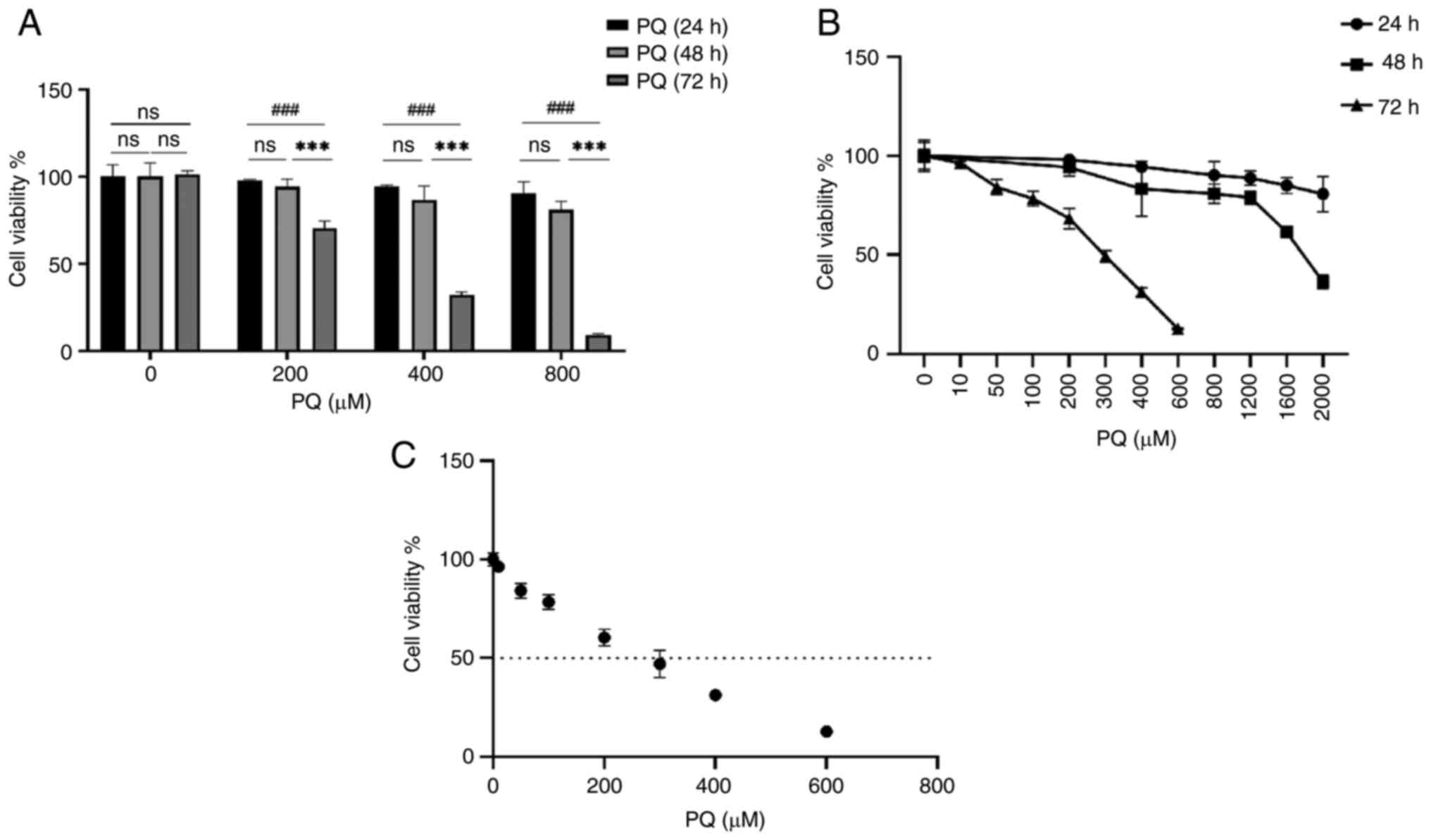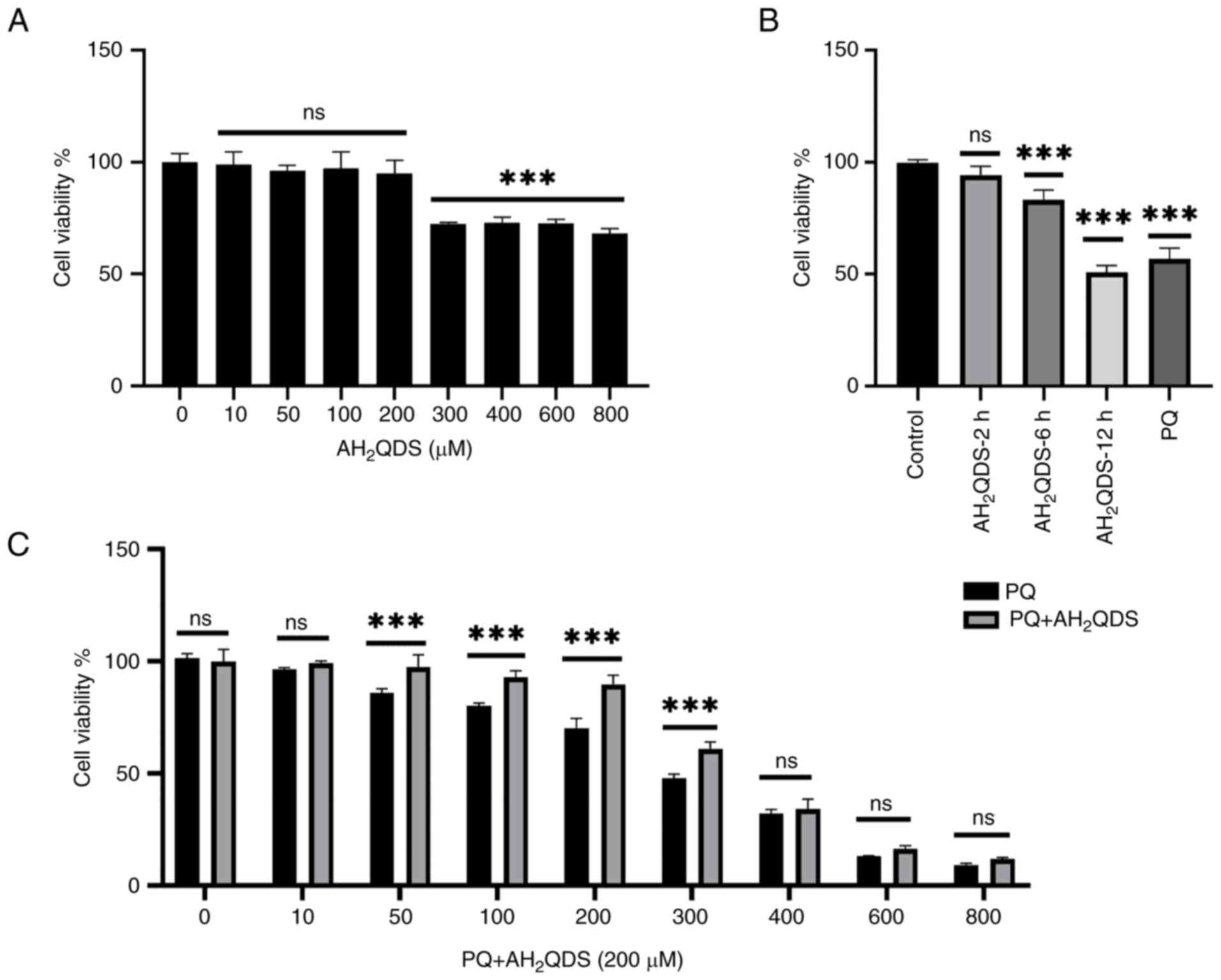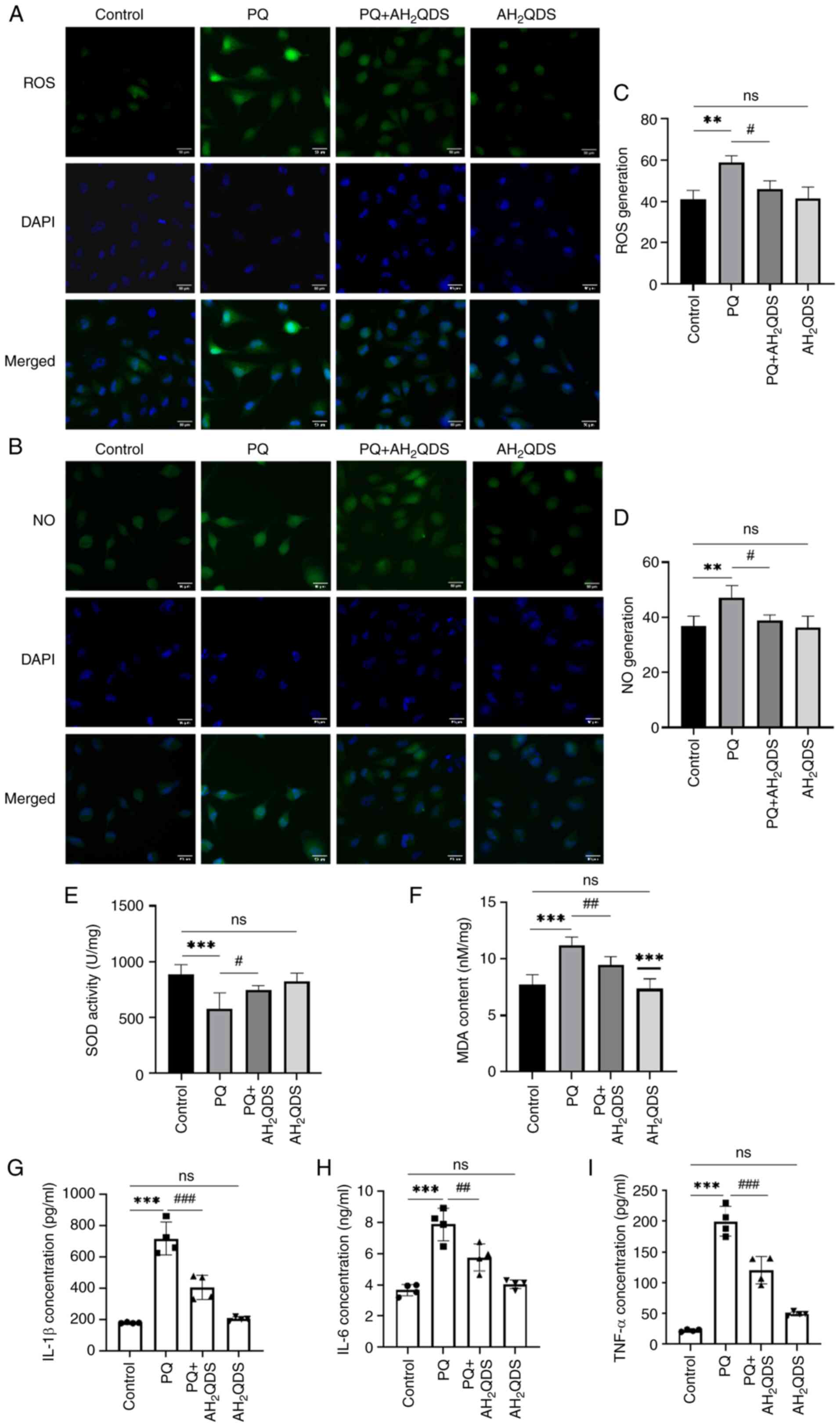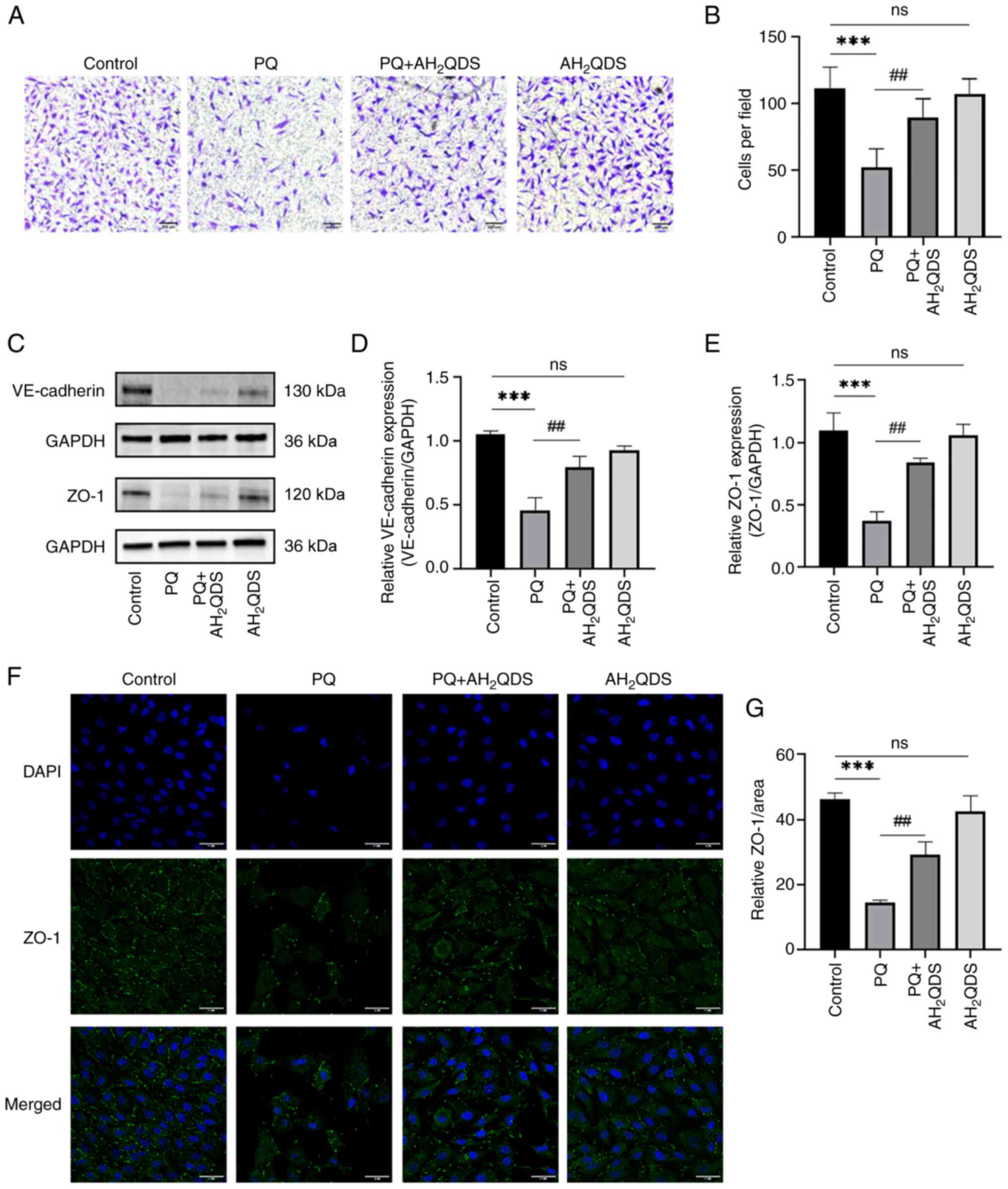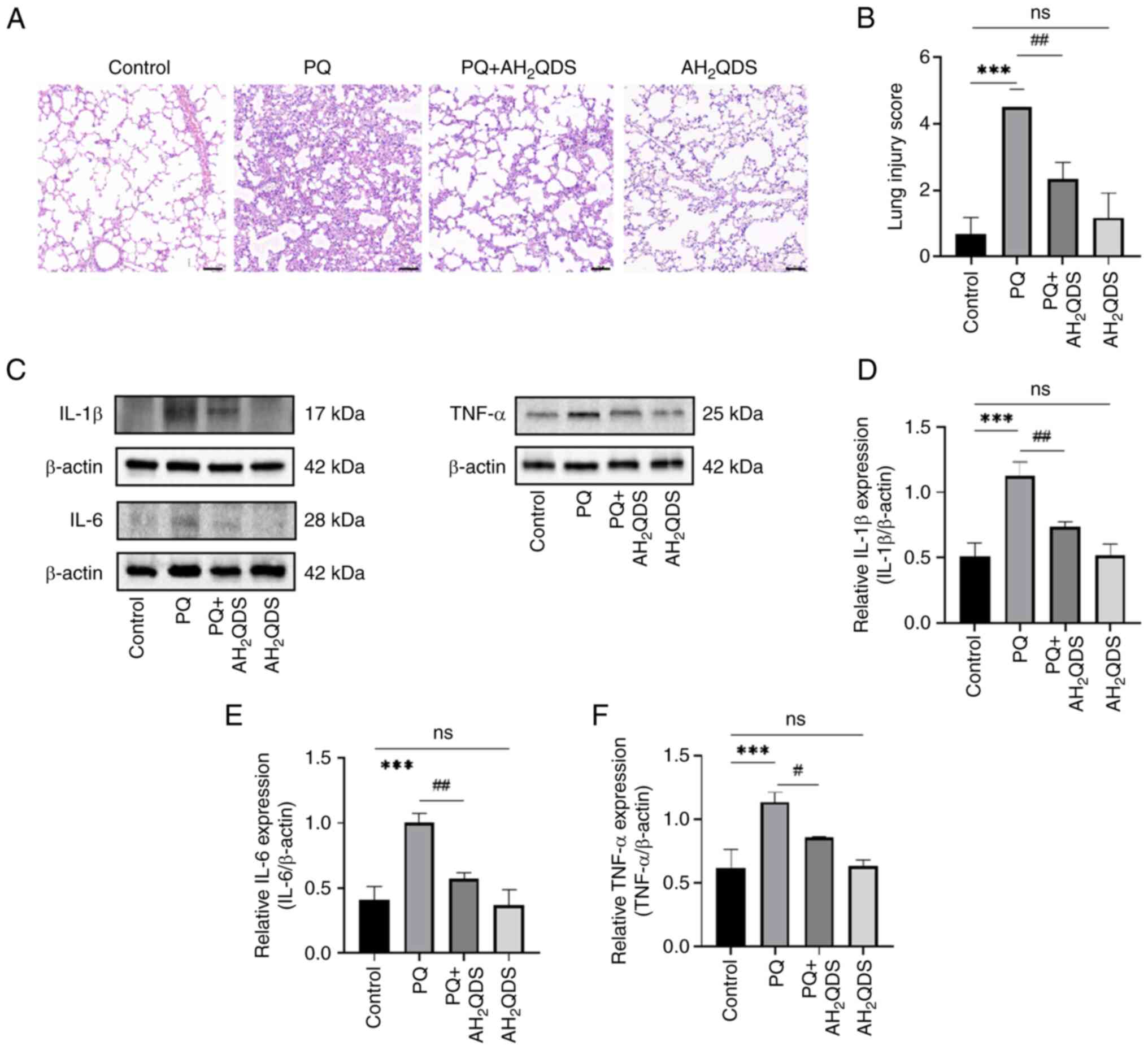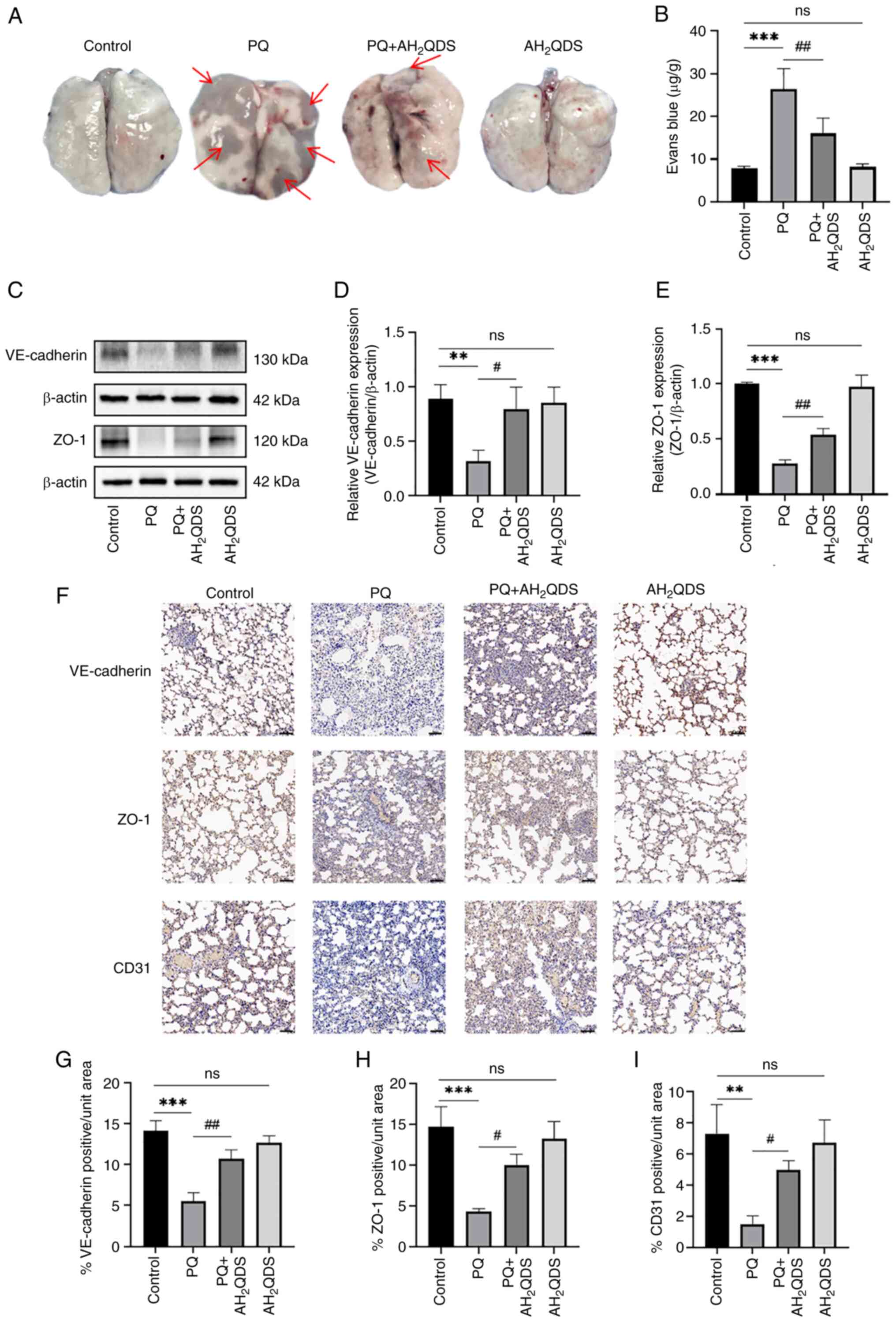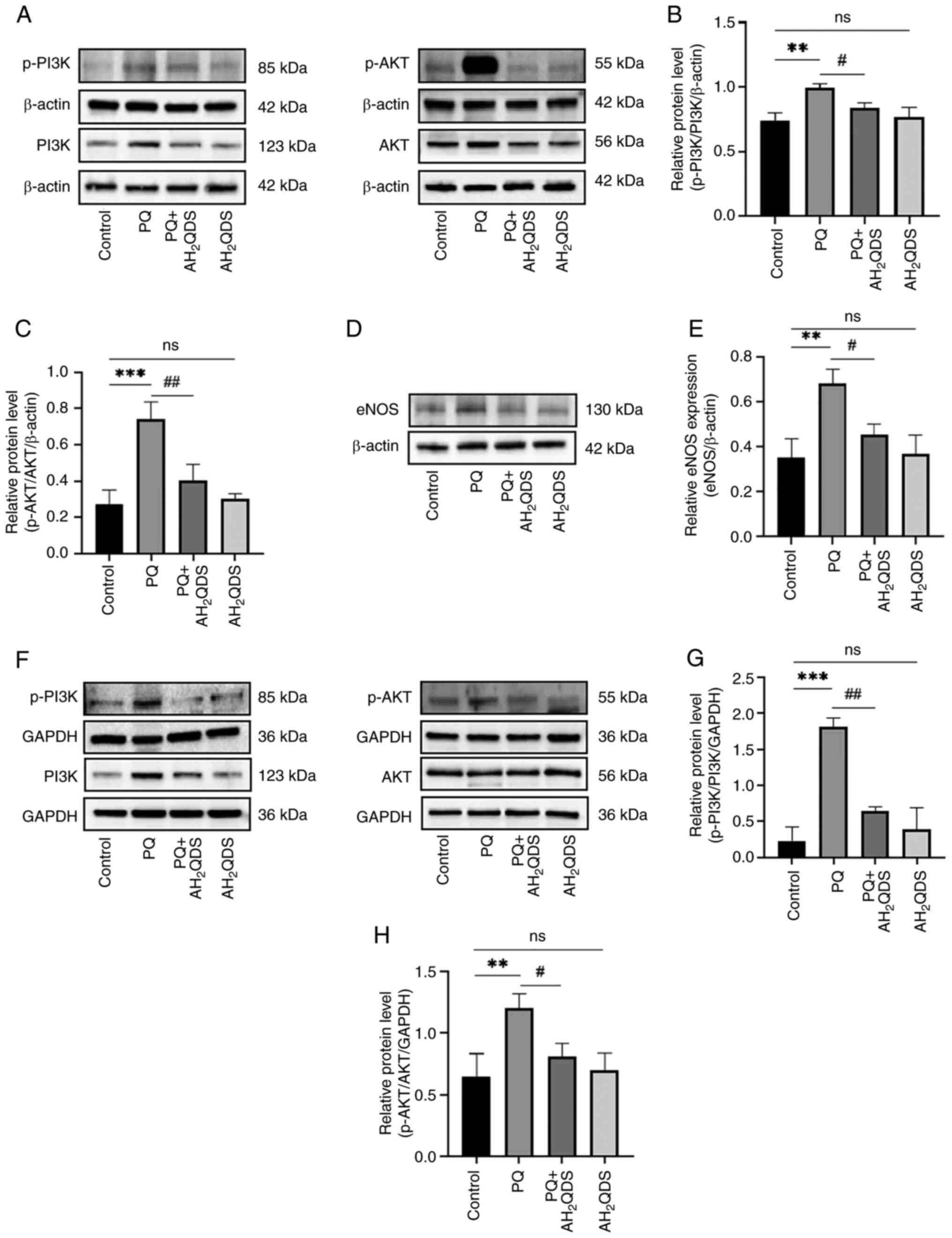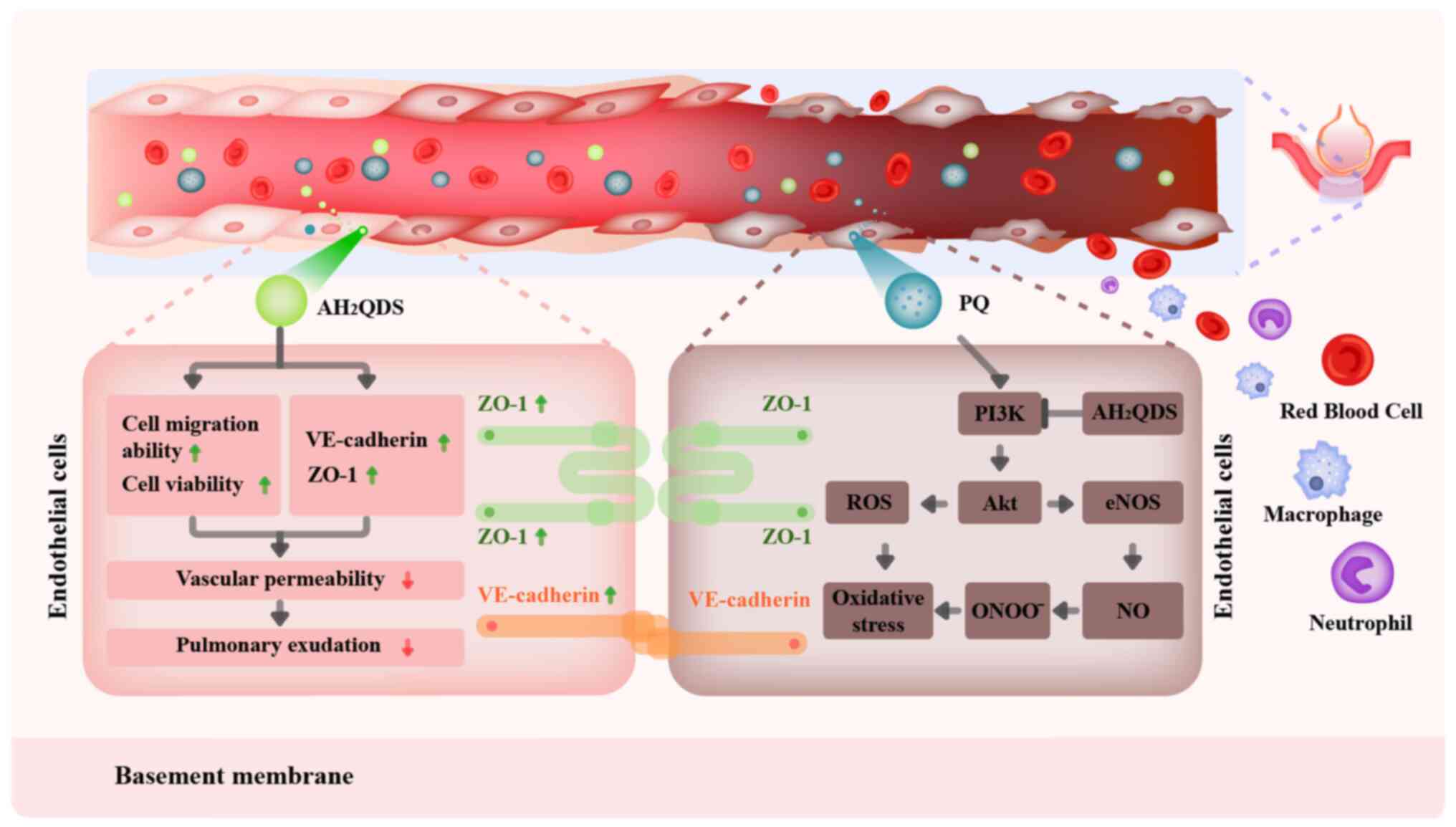|
1
|
Zhang D, Shen F, Ma S, Nan S, Ma Y, Ren L,
Li H and Yu Q: Andrographolide alleviates paraquat-induced acute
lung injury by activating the Nrf2/HO-1 pathway. Iran J Basic Med
Sci. 26:653–661. 2023.PubMed/NCBI
|
|
2
|
Amin F, Memarzia A, Roohbakhsh A, Shakeri
F and Boskabady MH: Zataria multiflora and pioglitazone affect
systemic inflammation and oxidative stress induced by inhaled
paraquat in rats. Mediators Inflamm. 2021:55750592021. View Article : Google Scholar : PubMed/NCBI
|
|
3
|
Ying H, Kang Y, Zhang H, Zhao D, Xia J, Lu
Z, Wang H, Xu F and Shi L: MiR-127 modulates macrophage
polarization and promotes lung inflammation and injury by
activating the JNK pathway. J Immunol. 194:1239–1251. 2015.
View Article : Google Scholar
|
|
4
|
Zhang Y, Yuan D, Li Y, Yang F, Hou L, Yu
Y, Sun C, Duan G, Meng C, Yan H, et al: Paraquat promotes acute
lung injury in rats by regulating alveolar macrophage polarization
through glycolysis. Ecotoxicol Environ Saf. 223:1125712021.
View Article : Google Scholar : PubMed/NCBI
|
|
5
|
Li Y, Wang N, Ma Z, Wang Y, Yuan Y, Zhong
Z, Hong Y and Zhao M: Lipoxin A4 protects against paraquat-induced
acute lung injury by inhibiting the TLR4/MyD88-mediated activation
of the NF-κB and PI3K/AKT pathways. Int J Mol Med. 47:862021.
View Article : Google Scholar
|
|
6
|
Li T, Cheng S, Xu L, Lin P and Shao M:
Yue-bi-tang attenuates adriamycin-induced nephropathy edema through
decreasing renal microvascular permeability via inhibition of the
Cav-1/eNOS pathway. Front Pharmacol. 14:11389002023. View Article : Google Scholar
|
|
7
|
Huang Y and He Q: Inhibition of c-Src
protects paraquat induced microvascular endothelial injury by
modulating caveolin-1 phosphorylation and caveolae mediated
transcellular permeability. Environ Toxicol Pharmacol. 52:62–68.
2017. View Article : Google Scholar : PubMed/NCBI
|
|
8
|
Hu J, Chen R, An J, Wang Y, Liang M and
Huang K: Dauricine attenuates vascular endothelial inflammation
through inhibiting NF-κB pathway. Front Pharmacol. 12:7589622021.
View Article : Google Scholar
|
|
9
|
Wu B, Xu MM, Fan C, Feng CL, Lu QK, Lu HM,
Xiang CG, Bai F, Wang HY, Wu YW and Tang W: STING inhibitor
ameliorates LPS-induced ALI by preventing vascular endothelial
cells-mediated immune cells chemotaxis and adhesion. Acta Pharmacol
Sin. 43:2055–2066. 2022. View Article : Google Scholar :
|
|
10
|
Lin F, Yang Y, Wei S, Huang X, Peng Z, Ke
X, Zeng Z and Song Y: Hydrogen sulfide protects against high
glucose-induced human umbilical vein endothelial cell injury
through activating PI3K/Akt/eNOS pathway. Drug Des Devel Ther.
14:621–633. 2020. View Article : Google Scholar : PubMed/NCBI
|
|
11
|
Wang RH, Xie YX, Qiu JW and Chen JY:
Influence of LincRNA-p21 on acute lung injury in sepsis. Eur Rev
Med Pharmacol Sci. 24:5618–5626. 2020.PubMed/NCBI
|
|
12
|
Hao Y, Wang Z, Frimpong F and Chen X:
Calcium-permeable channels and endothelial dysfunction in acute
lung injury. Curr Issues Mol Biol. 44:2217–2229. 2022. View Article : Google Scholar : PubMed/NCBI
|
|
13
|
Duan Y, Learoyd J, Meliton AY, Leff AR and
Zhu X: Inhibition of Pyk2 blocks lung inflammation and injury in a
mouse model of acute lung injury. Respir Res. 13:42012. View Article : Google Scholar : PubMed/NCBI
|
|
14
|
Pang L, Deng P, Liang YD, Qian JY, Wu LC,
Yang LL, Yu ZP and Zhou Z: Lipoic acid antagonizes paraquat-induced
vascular endothelial dysfunction by suppressing mitochondrial
reactive oxidative stress. Toxicol Res (Camb). 8:918–927. 2019.
View Article : Google Scholar
|
|
15
|
Cong P, Tong C, Mao S, Shi L, Shi X, Liu
Y, Jin H, Liu Y and Hou M: DDAH1 promotes lung endothelial barrier
repair by decreasing leukocyte transendothelial migration and
oxidative stress in explosion-induced lung injury. Oxid Med Cell
Longev. 2022:84076352022. View Article : Google Scholar : PubMed/NCBI
|
|
16
|
Wu C, Li F and Zhou S: Humus respiration
and its ecological significance. Acta Ecol Sin. 29:1535–1542.
2009.
|
|
17
|
Chunyuan W, Qinfen L and Dongming W: A
rapid detoxification solution and method for glyphosate. CN Patent
201610341330.6. Filed May 23, 2016; issued September 21, 2016.
|
|
18
|
Wu C, Wu D, Liu X, Qian J and Li Q: A
specific antidote for acute paraquat poisoning. CN Patent
201910908879.2. Filed September 25, 2019; issued December 20,
2019.
|
|
19
|
Qian J, Wu CY, Wu DM, Li LH, Li Q, Deng T,
Huang QF, Xu SQ, Wang HF, Wu XX, et al:
Anthrahydroquinone-2-6-disulfonate is a novel, powerful antidote
for paraquat poisoning. Sci Rep. 11:201592021. View Article : Google Scholar : PubMed/NCBI
|
|
20
|
Li Q, Wang B, Lin KW, Deng T, Huang QF, Xu
SQ, Wang HF, Wu XX, Li N, Yi Y, et al:
Anthrahydroquinone-2,6-disulfonate alleviates paraquat-induced
kidney injury via the apelin-APJ pathway in rats. Asian Pac J Trop
Biomed. 12:333–342. 2022. View Article : Google Scholar
|
|
21
|
Ahmed MAE, El Morsy EM and Ahmed AAE:
Protective effects of febuxostat against paraquat-induced lung
toxicity in rats: Impact on RAGE/PI3K/Akt pathway and downstream
inflammatory cascades. Life Sci. 221:56–64. 2019. View Article : Google Scholar : PubMed/NCBI
|
|
22
|
Luo W, Tao Y, Chen S, Luo H, Li X, Qu S,
Chen K and Zeng C: Rosmarinic acid ameliorates pulmonary
ischemia/reperfusion injury by activating the PI3K/Akt signaling
pathway. Front Pharmacol. 13:8609442022. View Article : Google Scholar : PubMed/NCBI
|
|
23
|
Qi D, Tang X, He J, Wang D, Zhao Y, Deng
W, Deng X, Zhou G, Xia J, Zhong X and Pu S: Omentin protects
against LPS-induced ARDS through suppressing pulmonary inflammation
and promoting endothelial barrier via an Akt/eNOS-dependent
mechanism. Cell Death Dis. 7:e23602016. View Article : Google Scholar : PubMed/NCBI
|
|
24
|
Gopallawa I, Kuek LE, Adappa ND, Palmer JN
and Lee RJ: Small-molecule Akt-activation in airway cells induces
NO production and reduces IL-8 transcription through Nrf-2. Resp
Res. 22:2672021. View Article : Google Scholar
|
|
25
|
Liu F, Sa Y, Li Y, Liu R, Wang Z, Li S,
Zhang Y and Ma Z: Research progress on the correlation between
acute hypoxic lung injury and NO, eNOS. Med Innov China.
19:184–188. 2022.In Chinese.
|
|
26
|
Li N, Huang Y, Yi Y, Qian J, Li Q, Xu SQ,
Wang HF, Wu XX, Peng JC, Li LH, et al: Analysis of abnormal
expression of signaling pathways in PQ-induced acute lung injury in
SD rats based on RNA-seq technology. Inhal Toxicol. 36:1–12. 2024.
View Article : Google Scholar : PubMed/NCBI
|
|
27
|
Chen H, Li N, Zhan X, Zheng T, Huang X,
Chen Q, Song Z, Yang F, Nie H, Zhang Y, et al: Capsaicin protects
against lipopolysaccharide-induced acute lung injury through the
HMGB1/NF-κB and PI3K/AKT/mTOR pathways. J Inflamm Res.
14:5291–5304. 2021. View Article : Google Scholar :
|
|
28
|
Tatjana V, Domitille S and Jean-Charles S:
Paraquat-induced cholesterol biosynthesis proteins dysregulation in
human brain microvascular endothelial cells. Sci Rep. 11:181372021.
View Article : Google Scholar : PubMed/NCBI
|
|
29
|
Song CY, Feng MX, Li L, Wang P, Lu X and
Lu YQ: Tripterygium wilfordii Hook.f. ameliorates paraquat-induced
lung injury by reducing oxidative stress and ferroptosis via
Nrf2/HO-1 pathway. Ecotoxicol Environ Saf. 252:1145752023.
View Article : Google Scholar : PubMed/NCBI
|
|
30
|
Jiang J, Huang K, Xu S, Garcia JGN, Wang C
and Cai H: Targeting NOX4 alleviates sepsis-induced acute lung
injury via attenuation of redox-sensitive activation of
CaMKII/ERK1/2/MLCK and endothelial cell barrier dysfunction. Redox
Biol. 36:1016382020. View Article : Google Scholar : PubMed/NCBI
|
|
31
|
Cai Q, Jin Y, Jia Z and Liu Z: Paraquat
induces lung injury via miR-199-mediated SET in a mouse model.
Front Pharmacol. 13:8564412022. View Article : Google Scholar : PubMed/NCBI
|
|
32
|
Shen K, Wang X, Wang Y, Jia Y, Zhang Y,
Wang K, Luo L, Cai W, Li J, Li S, et al: miR-125b-5p in adipose
derived stem cells exosome alleviates pulmonary microvascular
endothelial cells ferroptosis via Keap1/Nrf2/GPX4 in sepsis lung
injury. Redox Biol. 62:1026552023. View Article : Google Scholar : PubMed/NCBI
|
|
33
|
Kim Y, Bae CR, Kim D, Kim H, Lee S, Zhang
H, Noh M, Kim YM, Mochizuki N and Kwon YG: Efficacy of CU06-1004
via regulation of inflammation and endothelial permeability in
LPS-induced acute lung injury. J Inflamm (Lond). 20:132023.
View Article : Google Scholar : PubMed/NCBI
|
|
34
|
Komarova YA, Kruse K, Mehta D and Malik
AB: Protein interactions at endothelial junctions and signaling
mechanisms regulating endothelial permeability. Circ Res.
120:179–206. 2017. View Article : Google Scholar : PubMed/NCBI
|
|
35
|
Dong W, He B, Qian H, Liu Q, Wang D, Li J,
Wei Z, Wang Z, Xu Z, Wu G, et al: RAB26-dependent autophagy
protects adherens junctional integrity in acute lung injury.
Autophagy. 14:1677–1692. 2018. View Article : Google Scholar : PubMed/NCBI
|
|
36
|
Meng XY, Lu QY, Zhang JF, Li JF, Shi MY,
Huang SY, Yu SF, Zhao YM and Fan HJ: A novel animal model of
primary blast lung injury and its pathological changes in mice. J
Trauma Acute Care Surg. 93:530–537. 2022. View Article : Google Scholar : PubMed/NCBI
|
|
37
|
Xia W, Zhang H, Pan Z, Li G, Zhou Q, Hu D
and Liu Y: Inhibition of MRP4 alleviates sepsis-induced acute lung
injury in rats. Int Immunopharmacol. 72:211–217. 2019. View Article : Google Scholar : PubMed/NCBI
|
|
38
|
Zhou W, Shi G, Bai J, Ma S, Liu Q and Ma
X: Colquhounia root tablet protects rat pulmonary microvascular
endothelial cells against TNF-α-induced injury by upregulating the
expression of tight junction proteins claudin-5 and ZO-1. Evid
Based Complement Alternat Med. 2018:10246342018. View Article : Google Scholar
|
|
39
|
Birnhuber A, Fließer E, Gorkiewicz G,
Zacharias M, Seeliger B, David S, Welte T, Schmidt J, Olschewski H,
Wygrecka M and Kwapiszewska G: Between inflammation and thrombosis:
Endothelial cells in COVID-19. Eur Respir J. 58:21003772021.
View Article : Google Scholar : PubMed/NCBI
|
|
40
|
Zhao Y, Jin H, Lei K, Bai LP, Pan H, Wang
C, Zhu X, Tang Y, Guo Z, Cai J and Li T: Oridonin inhibits
inflammation of epithelial cells via dual-targeting of CD31 Keap1
to ameliorate acute lung injury. Front Immunol. 14:11633972023.
View Article : Google Scholar : PubMed/NCBI
|
|
41
|
Yang N, Tian H, Zhan E, Zhai L, Jiao P,
Yao S, Lu G, Mu Q, Wang J, Zhao A, et al: Reverse-D-4F improves
endothelial progenitor cell function and attenuates LPS-induced
acute lung injury. Respir Res. 20:1312019. View Article : Google Scholar : PubMed/NCBI
|
|
42
|
Chen DQ, Shen MJ, Wang H, Li Y, Tang AL,
Li S, Xiong MC, Guo Y and Zhang GQ: Sirt3 maintains microvascular
endothelial adherens junction integrity to alleviate sepsis-induced
lung inflammation by modulating the interaction of VE-cadherin and
β-catenin. Oxid Med Cell Longev. 2021:89787952021. View Article : Google Scholar
|
|
43
|
Singh D, Kumar V and Singh C: IFN-γ
regulates xanthine oxidase-mediated iNOS-independent oxidative
stress in maneb- and paraquat-treated rat polymorphonuclear
leukocytes. Mol Cell Biochem. 427:133–143. 2017. View Article : Google Scholar
|
|
44
|
Li N, Sun W, Zhou X, Gong H, Chen Y, Chen
D and Xiang F: Dihydroartemisinin protects against dextran sulfate
sodium-induced colitis in mice through inhibiting the PI3K/AKT and
NF-κB signaling pathways. Biomed Res Int. 2019:14158092019.
View Article : Google Scholar
|
|
45
|
Wang L, Tang X and Li S: Propofol promotes
migration, alleviates inflammation, and apoptosis of
lipopolysaccharide-induced human pulmonary microvascular
endothelial cells by activating PI3K/AKT signaling pathway via
upregulating APOM expression. Drug Dev Res. 83:397–406. 2022.
View Article : Google Scholar
|
|
46
|
Li YH, Yuan Y, Wang YW and Zhao M: The
role of PI3K/AKT-mediated apoptosis signaling pathway in paraquat
poisoning-induced cardiac injury. Chin J Diffic Compl Cas.
20:278–282. 2021.
|
|
47
|
Zhong R, Xia T, Wang Y, Ding Z, Li W, Chen
Y, Peng M, Li C, Zhang H and Shu Z: Physalin B ameliorates
inflammatory responses in lipopolysaccharide-induced acute lung
injury mice by inhibiting NF-κB and NLRP3 via the activation of the
PI3K/Akt pathway. J Ethnopharmacol. 284:1147772022. View Article : Google Scholar
|
|
48
|
Xin W, Yanxia Z, Haixia L, Aijun L, Shuang
L, Huimin C and Zheng CW: Effect of i NOS and cell apoptosis on
renal injury in rats with acute paraquat poisoning. Mod J Integr
Traditi Chin West Med. 25:2747–2750. 2016.
|
|
49
|
Evans CE, Peng Y, Zhu MM, Dai Z, Zhang X
and Zhao YY: Rabeprazole promotes vascular repair and resolution of
sepsis-induced inflammatory lung injury through HIF-1α. Cells.
11:14252022. View Article : Google Scholar
|
|
50
|
Hughes T, Dijkstra KK, Rawlins EL and
Hynds RE: Open questions in human lung organoid research. Front
Pharmacol. 13:10830172023. View Article : Google Scholar : PubMed/NCBI
|
|
51
|
Liberti DC and Morrisey EE: Organoid
models: Assessing lung cell fate decisions and disease responses.
Trends Mol Med. 27:1159–1174. 2021. View Article : Google Scholar : PubMed/NCBI
|
|
52
|
Bojkova D, Klann K, Koch B, Widera M,
Krause D, Ciesek S, Cinatl J and Münch C: Proteomics of
SARS-CoV-2-infected host cells reveals therapy targets. Nature.
583:469–472. 2020. View Article : Google Scholar : PubMed/NCBI
|
|
53
|
Riva L, Yuan S, Yin X, Martin-Sancho L,
Matsunaga N, Pache L, Burgstaller-Muehlbacher S, De Jesus PD,
Teriete P, Hull MV, et al: Discovery of SARS-CoV-2 antiviral drugs
through large-scale compound repurposing. Nature. 586:113–119.
2020. View Article : Google Scholar : PubMed/NCBI
|
|
54
|
Okabe R, Chen-Yoshikawa TF, Yoshizawa A,
Hirashima T, Saito M, Date H and Takebe T: Orthotopic foetal lung
tissue direct injection into lung showed a preventive effect
against paraquat-induced acute lung injury in mice. Eur J
Cardiothorac Surg. 58:638–645. 2020. View Article : Google Scholar : PubMed/NCBI
|
|
55
|
Chen L, Yu T, Zhai Y, Nie H, Li X and Ding
Y: Luteolin enhances transepithelial sodium transport in the lung
alveolar model: Integrating network pharmacology and mechanism
study. Int J Mol Sci. 24:101222023. View Article : Google Scholar : PubMed/NCBI
|















